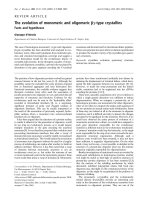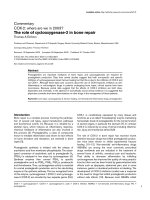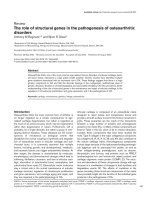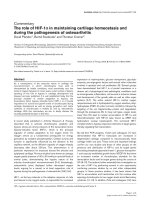Báo cáo y học: "The nature of unmeasured anions in critically ill patients" potx
Bạn đang xem bản rút gọn của tài liệu. Xem và tải ngay bản đầy đủ của tài liệu tại đây (35.47 KB, 1 trang )
Page 1 of 1
(page number not for citation purposes)
Available online />We read with interest the commentary of Venkatesh and
Morgan in the February issue of Critical Care [1], in which
they discuss the continuing need for clarification of the nature
of unmeasured anions in critically ill patients. The questions
asked in this commentary arise from the study of Bruegger
and colleagues in a previous issue of this journal [2]. The
main issue discussed is the ongoing uncertainty about the
contribution of intermediates of the tricarboxylic acid (TCA)
cycle to the strong ion gap (SIG). As Venkatesh and Morgan
accurately point out, the extremely high concentrations of
acetate and citrate found by Bruegger and colleagues may
very well be confounded by the exogenous administration of
resuscitation fluids and blood products in the animal model
described.
In the March issue of Critical Care Medicine, we published
our study conducted in critically ill patients with a metabolic
acidosis with and without an increased SIG, representing the
absence or presence of unmeasured anions [3]. We explored
the presence of and contribution to the SIG of a large variety
of compounds, largely organic acids and amino acids, by use
of several laboratory techniques such as ion-exchange
column chromatography and gas chromatography. In
addition, proton nuclear magnetic resonance (
1
H-NMR)
spectroscopy was used to quantify intermediates of the TCA
cycle. Despite our elaborate attempt, only 7.9% of the
difference in SIG between the low and high SIG groups
could be explained by the presence of high concentrations of
amino acids, uric acid, and organic acids. As a single
compound, uric acid was responsible for the largest relative
contribution to the SIG, namely 2.2%.
Our study excludes many other potent unmeasured anions,
such as uremic toxins and pyroglutamic acid, as major
contributors to the SIG. As to the presence of TCA cycle
intermediates, only succinic acid was significantly elevated in
the high SIG group but it accounted for only 0.07% of the
increased SIG. Furthermore, concentrations of isocitrate and
citrate obtained by gas chromatography were not relevantly
elevated in the high SIG group and all intermediates of the
TCA cycle quantified with
1
H-NMR spectroscopy, including
acetic acid, corresponded to the published reference ranges.
As outlined in our discussion, these findings are in
contradiction to a recent human study [4]. The accumulation
of TCA cycle intermediates by the mechanism of accelerated
amino acid catabolism would imply distinct patterns of altered
amino acid concentrations, which also was not supported by
the results of our study.
Our research enables us to answer the last question posed in
the commentary of Venkatesh and Morgan. Raised concen-
trations of (iso)citrate and acetate do not clarify the SIG in the
critically ill. Thus, a significant contribution of TCA cycle inter-
mediates to the SIG in human acidosis is excluded. However,
given the small percentage of the SIG that was represented
by the measured anions, a largely unclarified portion of the
strong anion gap remains to be explored.
Competing interests
The authors declare that they have no competing interests.
References
1. Venkatesh B, Morgan TJ: Unmeasured anions: the unknown
unknowns. Crit Care 2008, 12:113.
2. Bruegger D, Kemming GI, Jacob M, Meisner FG, Wojtczyk CJ,
Packert KB, Keipert PE, Faithfull S, Habler OP, Becker BF, Rehm
M: Causes of metabolic acidosis in canine hemorrhagic
shock: role of unmeasured ions. Crit Care 2007, 11:R130.
3. Moviat, MAM, Terpstra AM, Ruitenbeek W, Kluijtmans LAJ, Pick-
kers P, van der Hoeven JG: Contribution of various metabolites
to the “unmeasured” anions in critically ill patients with meta-
bolic acidosis. Crit Care Med 2008, 36:752-758.
4. Forni LG, McKinnon W, Lord GA, Treacher DF, Peron JM, Hilton
PJ: Circulating anions usually associated with the Krebs cycle
in patients with metabolic acidosis. Crit Care 2005, 9:R591-
R595.
Letter
The nature of unmeasured anions in critically ill patients
Miriam AM Moviat, Peter Pickkers, Wim Ruitenbeek and Johannes G van der Hoeven
Department of Intensive Care Medicine, Radboud University Nijmegen Medical Centre, Postbus 9101; 6500 HB Nijmegen, The Netherlands
Corresponding author: Miriam AM Moviat,
Published: 22 April 2008 Critical Care 2008, 12:416 (doi:10.1186/cc6855)
This article is online at />© 2008 BioMed Central Ltd
See related commentary by Venkatesh and Morgan, />1
H-NMR = proton nuclear magnetic resonance; SIG = strong ion gap; TCA = tricarboxylic acid.









